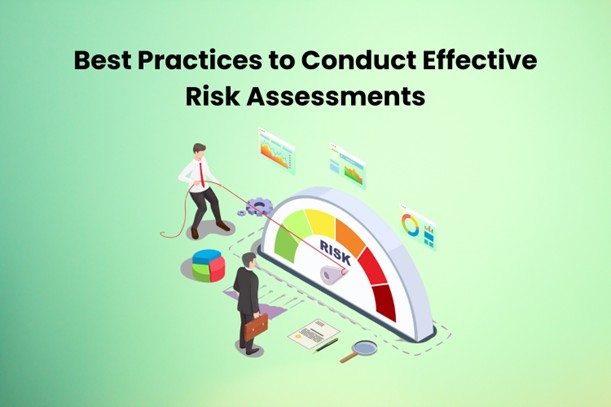Best practices to conduct effective risk assessments guide, Workplace safety tips, Secure office processes advice
Best Practices to Conduct Effective Risk Assessments
9 March 2024
Performing thorough risk assessments is crucial for workplace safety. Companies are realising how important it is to manage risks proactively to protect the health of their employees and keep things running smoothly. In this blog, we will explore the best practices for efficient risk assessments, highlighting the vital actions and factors that companies need to consider.
Before we get started, it’s important to remember that you may greatly improve your ability to manage risk assessments by keeping up-to-date and knowledgeable through credible training programs, such as IOSH Course like IOSH Managing Safely Risk Assessment training.
Table of Contents
- The Essence of Risk Assessments
- Importance of IOSH Managing Safely Courses
- Best Practices for Effective Risk Assessments
- Clearly Define Objectives and Scope
- Identify and Involve Stakeholders
- Thoroughly Identify Hazards
- Evaluate and Prioritise Risks
- Implement Control Measures
- Document the Process
- Regularly Review and Update Assessments
- Encourage Employee Involvement in the Process
- Conduct Periodic Training and Refreshers
- Conclusion
The Essence of Risk Assessments
The foundation of any effective health and safety strategy is risk assessment. They entail spotting possible dangers, assessing the risks they present, and putting control mechanisms in place to lessen those risks. The procedure guarantees that companies handle safety issues proactively rather than reactively.
Importance of IOSH Managing Safely Courses
Before delving into the optimal methodologies, it is imperative to recognise the significance of educational initiatives such as IOSH courses in providing practitioners with the expertise and abilities required to carry out efficient risk assessments. For individuals dedicated to upholding a safe workplace, the IOSH Managing Safely risk assessment program is an indispensable tool as it offers a thorough comprehension of the risk assessment procedure.
Best Practices for Effective Risk Assessments
Clearly Define Objectives and Scope
Setting specific goals and parameters is essential before starting a risk assessment. What objectives does the evaluation have, and what aspects of the workplace will it cover? Setting these boundaries makes the assessment more focused and guarantees no important detail is missed. Whether you are an experienced safety expert or a newbie to risk assessments via IOSH training, this first stage is the same.
Identify and Involve Stakeholders
A successful risk assessment needs input from a range of organisation stakeholders. Managers, frontline employees, and health and safety specialists fall under this category. Involving all pertinent stakeholders guarantees a comprehensive outlook, combining the tactical knowledge of local experts with the strategic judgments of decision-makers.
Thoroughly Identify Hazards
Use caution while determining whether there are any possible occupational dangers. This contains less evident threats in addition to the obvious ones. By utilising the insights acquired from IOSH Managing Safely risk assessment training, practitioners can cultivate an astute perception of possible hazards that may elude casual scrutiny.
Evaluate and Prioritise Risks
Not every hazard that has been discovered is equally dangerous. An essential component of a successful risk assessment process is ranking hazards according to their seriousness and probability of happening. By taking this action, companies can focus their attention and resources on the most urgent problems, taking the greatest risks on the first.
Implement Control Measures
After identifying and ranking risks, the next stage is to put control mechanisms in place. This entails coming up with effective plans to reduce or eliminate risks. The effectiveness of the control measures should be routinely assessed and updated, and they should comply with all applicable safety standards and laws.
Document the Process
Complete documentation is needed for performing successful risk assessments. Accurate documentation guarantees responsibility, openness, and a historical reference point for upcoming evaluations. The documentation must cover every phase of the evaluation, starting from the basic goals and ending with the control mechanisms put in place. Experts who have completed IOSH Managing Safely risk assessment training know the significance of thorough documentation.
Regularly Review and Update Assessments
Both the workplace and the threats it poses are dynamic. Regular reviews are essential to ensure risk assessments are still applicable and useful. Updates to control measures may be required in response to changes in the workplace, procedures, or laws. Professionals with the expertise gained from IOSH courses are well-equipped to adjust to these changes systematically.
Encourage Employee Involvement in the Process
Involve your employees in the risk assessment process to empower them. Workers frequently possess insightful knowledge of daily operations and can spot risks that management might miss. Establishing a culture that promotes candid dialogue about safety issues supports a team-based approach to risk assessment.
Conduct Periodic Training and Refreshers
Upholding a high standard of risk assessment inside an organisation requires ongoing education. Frequent training sessions and refresher courses, like those provided by IOSH courses, guarantee that workers and safety experts remain current on the latest advancements, rules, and best practices. This continuous learning fosters a culture of proactive safety.
Effective Risk Assessments Best Practices Conclusion
In summary, the cornerstone of a robust health and safety plan is an efficient risk assessment process. Businesses can establish safer working environments by adhering to best practices, including stating objectives and stakeholders and implementing control systems. One cannot emphasise the importance of credible training programs, such as IOSH courses, in providing professionals with the necessary abilities to handle the complexities of risk assessment.
Therefore, including these best practices and ongoing learning is essential to mastering the art of risk assessment in the workplace, regardless of experience level.
Comments on the guide to Best practices to conduct effective risk assessments article welcome
Glasgow Architecture
Major Strathclyde Building Designs – selection:
Historic Glasgow : best Glasgow architecture of the past
Comments / photos for the Best practices to conduct effective risk assessments advice page welcome.

